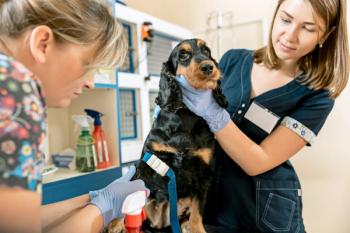
AAEP releases clinical guidelines for treating non-racing performance horses
White paper's authors question equine veterinarians' current mediciation and treatment practices.
In September, the American Association of Equine Practitioners' (AAEP's) Task Force on Medication in the Non-Racing Performance Horse released its clinical guidelines for veterinarians treating such animals.1 The guidelines are meant to enable practitioners to provide appropriate care of the horses involved in non-racing performance activities.
Welfare for all: The AAEP guidelines emphasize the fact that non-racing horses need the same considerations as those previously outlined for racehorses.
According to the guidelines, the AAEP thinks appropriate treatment of performance horses requires accurate diagnostics and the development of evidence-based therapeutic regimens. There's a concern that some non-racing performance horses are being treated with "under diagnosis and over treatment," and, in addition to veterinary care, "some horses may require periods of decreased activity as part of appropriate medical management."
What seemed most important to the task force was a concern for the well being and best interests of horses and that "the current use of medications to manage competition horses is often permissive and excessive."
Regardless of the treatment regimen, the guidelines state that treatment should be "based on thorough examination, the subsequent development of a differential diagnosis and a thorough understanding of the athletic and scheduling demands of the particular discipline in which the horse participates."
Task force member Scott Palmer, VMD, Dipl. ABVP, New Jersey Equine Clinic, Millstone Twp, N.J., notes, "When the AAEP Executive Committee reviewed the clinical guidelines created by the Racing Committee, it felt those concepts were applicable and relevant to other sport-horse disciplines. There are common concerns for non-racing performance horses and racing horses. Both are in competition and asked to perform at their best. Veterinarians are involved to help them do so. That's what stimulated the interest to create separate clinical guidelines for veterinarians treating the non-racing performance horse."
The task force included a number of equine veterinarians and specialists from around the country. In his role as chairperson of the AAEP's Racing Committee, with a sport-horse background, Palmer could lend perspective and bring additional insight to the committee on how the previous guidelines were drafted and how their similar concerns were addressed.
"The primary goal is to take care of the horse and put its welfare uppermost when you're making these medical decisions," says Palmer. "This concept should be the basis for the discussions in the owner-trainer-veterinarian relationship, both for racing horses and non-racing performance horses."
Summary of medication, treatment guidelines
The new guidelines advise:
- All therapeutic treatments for performance horses should be based on a specific diagnosis and treatment regimen.
- A valid and transparent owner-trainer-veterinarian relationship must be present.
- All therapeutic medications need to be administered under the direction of a licensed veterinarian.
- All therapeutic treatments should be given adequate time post-treatment for evaluation of their effectiveness before competition.
- All treatments are to be based on a concern for the well being, wellness, health and safety of the horse.
- No one should administer nontherapeutic or nonprescribed medications.
- Veterinarians should not use surgical procedures or injections of a foreign substance that could affect a horse's performance, except for those therapeutic treatments that protect the horse's health.
- No medication should be administered within 12 hours before a competition.
- Only one NSAID should be given and permitted in plasma and urine samples collected for testing purposes from performance horses.
Documentation of veterinary procedures
The new guidelines also advise:
- Medical records: All medical treatments and procedures performed on a horse in competition or training should be documented in the horse's medical record.
- Infectious disease control: Management of infectious disease at competitions and horse sales is a high priority for the general health of the horses (
click here to view guidelines ).
- Iatrogenic transmission of disease: With the potential of transmitting various infectious diseases (e.g., piroplasmosis, equine infectious anemia, equine influenza, equine herpesvirus, strangles), the AAEP recommends practitioners not reuse syringes, needles, etc.
- Drug compounding: Legal drug compounding requires a valid veterinarian-client-patient relationship. Compounded medications can be used only when no equivalent FDA-approved drug or medication is available (
click here to view guidelines ).
- Extra-label medications: Off-label (extra-label) medication is the use of an FDA-approved product for a condition other than that for which it's labeled or for use in another species. All the criteria for appropriate use of therapeutic medications apply to off-label use (
click here to view guidelines ).
Adjunctive therapeutic guidance
The guidelines' specific adjunctive therapeutic treatment recommendations include:
- Extracorporeal shockwave treatment (ESWT): The AAEP recommends that this form of treatment not be used within five days of competition since the length of therapeutic (analgesic) effect of ESWT is controversial. Committee chairperson Nathaniel White, DVM, MS, Dipl. ACVS, of Virginia Tech College of Veterinary Medicine says, "Immediately after shock-wave administration, we're concerned there's some analgesia that may cover up a painful condition that you wouldn't want to have present in competition or in a place where the horse might be injured."
- Acupuncture and chiropractic therapy: The AAEP recommends these therapies be based on a valid diagnosis and administered by or under the direct supervision of a licensed veterinarian. "There isn't a lot of information about acupuncture or chiropractic therapy in competition practice, so we haven't come out with a major recommendation in regard to their use," says White.
- Cold therapy: This form of therapy is considered a valid treatment when used for a specific condition. Cold therapy machines that can cool below 32 F (0 C) should never be used. White acknowledged that cold therapy is a valid treatment. The concern with this therapy is that the tissue not be subjected to excessive cooling or freezing. "Cold therapy is very beneficial to performance horses if it isn't abused, producing frostbite," he says.
The task force did not specifically address nutritional supplements. "There's some question about whether various nutritional supplements used to treat the competitive horse (e.g., oral hyaluronic acid, chondroitin, glucosamine) are absorbed (i.e., biologically available) and whether they're doing what they're prescribed for, what the label says they do," says White. "I don't think there's any harm, as with oral hyaluronic acid, but is it getting to the joints and effective to assist joint function? I'm not sure anybody knows. To me, it's a matter of whatever is safe for the horse and then buyer-beware, because we don't have any scientific proof that it's effective."
Other veterinary concerns
White thinks it's important that whenever a veterinarian treats a performance horse, no matter what the issue is, there should be an examination, a diagnosis and then an appropriate time to be able to evaluate the animal for response to the treatment.
"We feel it's important that maintenance therapy be based on a diagnosis," says White. There should be a recheck examination, rather than just retreating a horse for a problem that might have occurred in the past.
"Those are some of the main points we'd really like to get out to veterinarians, as well to horse organizations and owners," says White. "We feel there's some overtreatment, and in some cases we fear there's treatment with no real diagnosis or no real validation of the medication."
Many different professionals are involved in caring for non-racing performance horses, and everyone understands that when there is competition, you want the horses to do the very best they can.
"Often horsemen and veterinarians look to medication to help them achieve their goals," says Palmer. "We, those veterinarians involved in writing the white paper, feel you have to speak for the horse in this process and put the horse's welfare up there as part of those considerations. The current focus on the appropriate use of medication in both racing and the non-racing performance horse is justified."
The white paper includes discussion of the possible abuse of intra-articular injections, possible use of more than one NSAID or the overuse of analgesics and a concern for the maintenance use of drugs on a regular basis regardless of a diagnosis of disease directing their use.
The routine use of joint injections is a common practice both at the racetrack and in the horse-show circuit. For example, hunter-jumpers and dressage horses commonly have degenerative arthritis of the lower hock joints. As the show season approaches, many horsemen and veterinarians recommend injection of the hocks on a "prophylactic basis in hopes of ensuring a good performance."
White also noted a concern that multiple joint injections are being completed as a maintenance therapy. "This is being done as a maintenance regimen requested by the owner or recommended by some veterinarians," he says. "Yet there's no real reason for some of the joints to be injected, other than it's just done to make sure everything is OK. We don't think is in the best interests of the health of the horse."
White further notes that veterinarians shouldn't be administering analgesics during competition. "That's not fair to the horse and may lead to injury or increased health risks. It's important, as is stated in the document, that only one NSAID be used prior to competition, and no NSAIDS should be given within 12 hours of a competition. This is a logical medication schedule, so we don't have a lack of pain covering up a lameness problem, or of some painful problem that might result in injury to the horse."
Veterinarians must take responsibility for the creation of the concept of maintenance use of certain drugs, says Palmer. "At this point, I think it's fair to say we need to look at that practice in a critical way and decide if it's really necessary," he says. "That was a core concept in the racing guidelines, that first we make a diagnosis, then we treat the condition and then we evaluate that treatment before the horse enters further competition. The same thing applies to the non-racing performance horse. Maintenance treatments without a medical diagnosis may be unnecessary and are inappropriate. If the horse is sound, why do you take the risk of treating that horse with an invasive procedure, just in the anticipation that in a month or so, it might get lame?"
Ed Kane, PhD, is a researcher and consultant in animal nutrition. He is an author and editor on nutrition, physiology and veterinary medicine with a background in horses, pets and livestock. Kane is based in Seattle.
Reference
1. Clinical guidelines for veterinarians treating the non-racing performance horse. Lexington, Ky: American Association of Equine Practitioners, 2011. Available at
Newsletter
From exam room tips to practice management insights, get trusted veterinary news delivered straight to your inbox—subscribe to dvm360.






